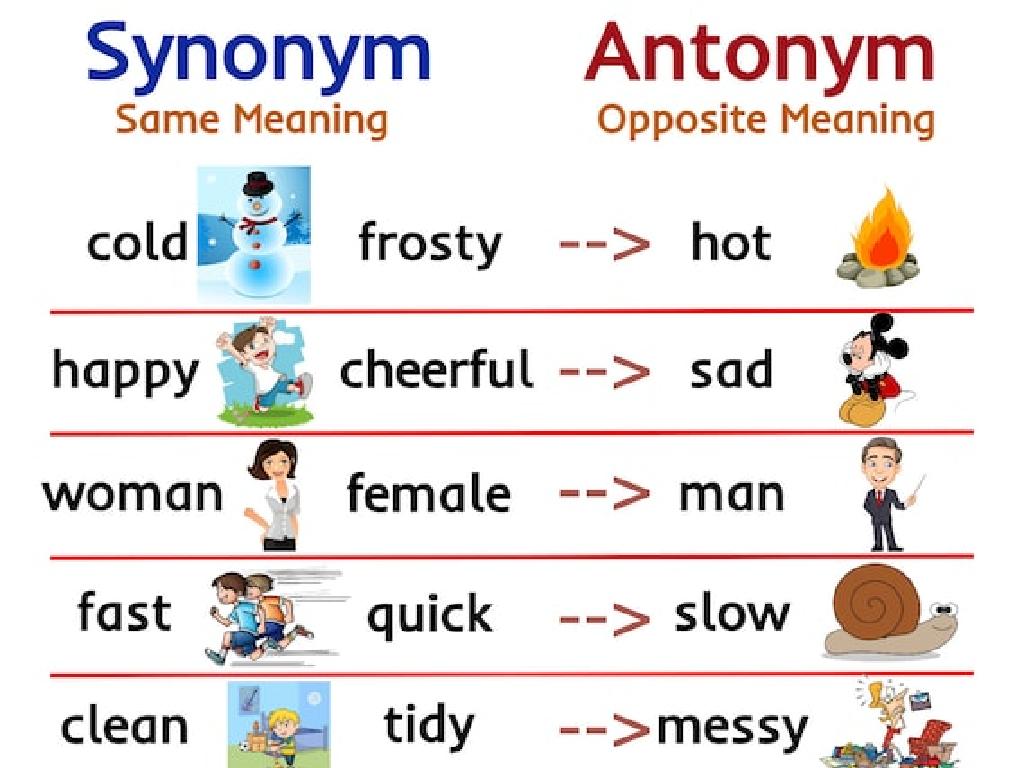How Do Air Masses Form?
Subject: Science
Grade: Seventh grade
Topic: Weather And Climate
Please LOG IN to download the presentation. Access is available to registered users only.
View More Content
Understanding Air Mass Formation
– Explore our atmosphere
– The atmosphere is a layer of gases surrounding Earth.
– Differentiate weather and climate
– Weather is short-term, climate is long-term atmospheric conditions.
– Formation of air masses
– Air masses form when air sits over an area and takes on its temperature and moisture characteristics.
– Factors influencing air masses
– Temperature, humidity, and surface features affect air mass properties.
|
This slide introduces the concept of air masses within the broader topics of weather and climate. Begin by discussing the Earth’s atmosphere and its importance to weather and climate. Clarify the difference between weather (day-to-day changes) and climate (long-term patterns). Then, focus on how air masses form, explaining that they are large bodies of air that develop over specific regions and acquire the characteristics of the area below (temperature and moisture). Highlight the factors that influence air masses, such as the surface features of the Earth (water bodies, mountains) and the local temperature and humidity levels. Encourage students to think about how these factors might change the air mass properties and lead to different weather conditions.
Understanding Weather and Its Components
– Weather vs. Climate: Defining terms
– Weather is day-to-day atmospheric conditions; climate is long-term patterns.
– Key Components of Weather
– Temperature, humidity, precipitation, wind, and pressure are weather elements.
– Weather’s Impact on Daily Life
– Weather influences clothing choices, activities, and can affect health.
– Introduction to Air Mass Formation
|
This slide aims to differentiate between weather and climate, setting the stage for a deeper discussion on how air masses form. Weather refers to the short-term state of the atmosphere, including temperature, humidity, precipitation, wind, and atmospheric pressure. Climate, on the other hand, is the average of these weather components over a longer period. Emphasize the importance of understanding weather’s components as they directly affect our daily lives, from what we wear to how we plan our day. Conclude with an introduction to the formation of air masses, which are large bodies of air with uniform temperature and humidity, as a lead-in to the next topic in the series.
Understanding Air Masses
– What is an Air Mass?
– A large body of air with uniform temperature and humidity
– Characteristics of Air Masses
– They can be cold or warm, and moist or dry depending on their source region
– Air Masses & Weather Formation
– They interact to create various weather conditions like storms or calm weather
– Observing Air Masses in Action
|
An air mass is a large volume of air that has consistent temperature and moisture levels throughout. It’s important for students to understand that the characteristics of an air mass are largely determined by the surface over which it forms, known as the source region. For example, air masses that form over oceans are typically moist, while those from deserts are dry. The interaction of different air masses can lead to the formation of weather phenomena such as thunderstorms, blizzards, or clear skies. Encourage students to observe the weather over a few days and try to identify changes that might be due to the movement of air masses.
Formation of Air Masses
– Air masses form over large areas
– They develop when the atmosphere over a large region sits relatively still, taking on characteristics from the surface below.
– Earth’s surface influences air mass
– Land heats and cools faster than water, affecting the temperature and humidity of the air above.
– Maritime vs. Continental air masses
– Maritime air masses form over oceans, are moist; Continental air masses form over land, are dry.
– Examples of air mass characteristics
– Maritime Tropical (mT) air masses are warm and humid, while Continental Polar (cP) air masses are cold and dry.
|
This slide introduces the concept of air mass formation and its dependence on the Earth’s surface. Air masses are large bodies of air that have uniform temperature and humidity characteristics. They form when the air remains over a large area, such as an ocean or a plain, for an extended period, allowing it to acquire the properties of the surface below. The type of surface whether it’s water or land plays a crucial role in determining these characteristics. For example, maritime air masses that form over oceans are typically moist due to evaporation, while continental air masses that form over land are drier. To illustrate this, compare Maritime Tropical air masses, which are warm and humid and typically found in regions like the Gulf of Mexico, to Continental Polar air masses, which are cold and dry, commonly found in northern Canada. Encourage students to think about how these differences in air masses can affect the weather they experience.
Exploring Types of Air Masses
– Classifying air masses
– Air masses are categorized based on their source region’s temperature and moisture.
– Tropical vs. Polar air masses
– Tropical air masses are warm, Polar are cold.
– Maritime vs. Continental
– Maritime air masses form over water and are moist, Continental form over land and are dry.
– Effects on weather
– These characteristics influence the weather patterns we experience.
|
This slide aims to educate students on the different types of air masses and their characteristics. Air masses are classified by the temperature and humidity of their source regions, leading to four main types: Tropical, Polar, Maritime, and Continental. Tropical air masses originate from warm regions and are typically hotter, whereas Polar air masses come from colder regions and are cooler. Maritime air masses form over bodies of water and are moist, while Continental air masses form over land and are drier. Understanding these differences is crucial for predicting weather patterns, as the interaction between different air masses can lead to various weather phenomena. Encourage students to think about how the air masses around their region might affect their local weather.
Air Masses and Weather Patterns
– Interaction of air masses with fronts
– Fronts are boundaries between air masses with different temperatures and humidity.
– Air masses’ impact on local weather
– Depending on their type, air masses can bring heat waves, cold spells, or storms.
– Case study: Nor’easters
– Nor’easters are powerful storms with heavy snow and strong winds, formed from cold air masses from the Arctic clashing with warm air from the Gulf Stream.
|
This slide explores the dynamics of air masses and their influence on weather patterns. Students will learn how fronts, which are the dividing lines between air masses, can lead to various weather conditions when these masses collide. Emphasize the role of temperature and humidity differences in creating fronts. Discuss how air masses can drastically change local weather, bringing about phenomena such as heat waves or cold spells. Use Nor’easters as a case study to illustrate how the interaction of warm and cold air masses can result in severe weather events. Encourage students to think about how these concepts apply to weather patterns they’ve experienced locally.
Tracking Air Masses: Meteorological Tools
– Tools used by meteorologists
– Satellites, weather balloons, and radar systems track air masses.
– How to read a weather map
– Symbols and colors on maps show different weather patterns.
– Identifying air masses and fronts
– Air masses are large bodies of air; fronts are boundaries between them.
– Predicting weather with air masses
– Air mass characteristics help forecast local weather conditions.
|
This slide introduces students to the tools and techniques meteorologists use to track and predict weather patterns. Emphasize the importance of satellites, weather balloons, and radar in providing real-time data on air masses. Teach students how to interpret the symbols and colors on a weather map to identify different air masses and the fronts where they meet. Explain that understanding the properties of air masses (like temperature and humidity) and their interaction at fronts is crucial for predicting weather changes. Encourage students to look at weather maps in their daily lives and try to predict the weather based on the information provided.
Class Activity: Create Your Own Weather Map
– Construct a weather map with materials
– Label different air masses and fronts
– Associate weather types with air masses
– For example, cold air masses may bring snow or cool temperatures
– Present and explain your weather predictions
|
This activity is designed to help students apply their knowledge of air masses and weather fronts by creating their own weather maps. Provide students with a variety of materials such as colored pencils, markers, and a base map. Guide them to identify and label different air masses such as maritime tropical or continental polar, and the fronts where these air masses meet. They should use their understanding of these concepts to predict the types of weather each air mass might bring to a region. For instance, a maritime tropical air mass might be associated with warm, humid weather, while a continental polar air mass could bring cold, dry conditions. Once students have completed their maps, have them present to the class and explain the reasoning behind their predictions. This will reinforce their understanding and allow for peer learning. Provide feedback and additional information as necessary to ensure a comprehensive understanding of the topic.





